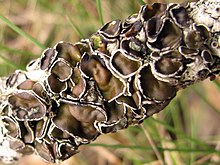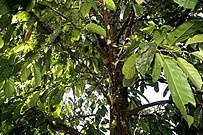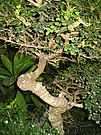
Architrypethelium is a genus of lichen-forming fungi in the family Trypetheliaceae.
André Aptroot is a Dutch mycologist and lichenologist.

Pyxine cocoes, commonly known as the buttoned rosette lichen, is a widely distributed species of foliose lichen in the family Caliciaceae.

Salazinic acid is a depsidone with a lactone ring. It is found in some lichens, and is especially prevalent in Parmotrema and Bulbothrix, where its presence or absence is often used to help classify species in those genera.
Cladonia lichexanthonica is a rare species of saxicolous (rock-dwelling) lichen in the family Cladoniaceae. Found in Bahia, Brazil, it was formally described as a new species in 2018 by lichenologists André Aptroot and Marcela Eugenia da Silva Cáceres. The type specimen was collected by the authors from the Morro do Pai Inácio at an altitude between 1,050 and 1,140 m ; here the lichen was found growing on siliceous sandstone rock in a transitional forest. Cladonia lichexanthonica is only known to occur at the type locality, and is only known from the type specimen. The lichen has a squamulose (scaley) thallus measuring up to 10 cm (4 in) in diameter; this consists of a 5-millimetre (0.2 in) thick crust comprising individual crowded squamules, pale-olive green to olive brown, measuring 1–5 mm in size. The specific epithet lichexanthonica refers to the presence of lichexanthone, a secondary compound that was not previously known to occur in genus Cladonia.
Pertusaria lichexanthofarinosa is a rare species of crustose and corticolous (bark-dwelling) lichen in the family Pertusariaceae. Found in Bahia, Brazil, it was formally described as a new species in 2018 by lichenologists André Aptroot and Marcela Eugenia da Silva Cáceres. The type specimen was collected by the authors near the Cachoeira do Mosquito at an altitude between 450 and 500 m ; here the lichen was found growing on tree bark in Atlantic Forest. Pertusaria lichexanthofarinosa is only known to occur at the type locality, and is only known from the type specimen. The specific epithet lichexanthofarinosa refers both to the presence of the cortical secondary chemical lichexanthone, as well as the farinose soredia.
Pertusaria lichexanthoimmersa is a rare species of crustose and corticolous (bark-dwelling) lichen in the family Pertusariaceae. Found in Bahia, Brazil, it was formally described as a new species in 2018 by lichenologists André Aptroot and Marcela Eugenia da Silva Cáceres. The type specimen was collected by the authors from the Morro do Pai Inácio at an altitude between 1,050 and 1,140 m ; here the lichen was found growing on tree bark in a transitional forest. Pertusaria lichexanthoimmersa is only known to occur at the type locality, and is only known from the type specimen. The specific epithet lichexanthoimmersa refers both to the presence of lichexanthone as a secondary chemical, and the apothecia, which are immersed in the thallus. The lichen also contains norstictic acid.
Pertusaria lichexanthoverrucosa is a rare species of crustose and corticolous (bark-dwelling) lichen in the family Pertusariaceae. Found in Bahia, Brazil, it was formally described as a new species in 2018 by lichenologists André Aptroot and Marcela Eugenia da Silva Cáceres. The type specimen was collected by the authors near the Cachoeira do Mosquito at an altitude between 450 and 500 m ; here the lichen was found growing on tree bark in Atlantic Forest near a river. Pertusaria lichexanthoverrucosa is only known to occur at the type locality, which is part of the Chapada Diamantina mountains. The specific epithet lichexanthoverrucosa refers to both the presence of lichexanthone as well as the verrucose (warty) thallus.
Chiodecton lichexanthonicum is a species of crustose and corticolous (bark-dwelling) lichen in the family Roccellaceae. Found in the Brazilian Amazon, it was formally described as a new species in 2017 by lichenologists Marcela Eugenia da Silva Cáceres and André Aptroot. The type was collected by the authors from the Adolfo Ducke Forest Reserve, along trails near a field station; here, in old-growth rainforest, it was found growing on tree bark. The specific epithet lichexanthonicum refers to its major cortical compound, lichexanthone. It is the first species in genus Chiodecton known to contain this compound. Chiodecton lichexanthonicum has narrow, club-shaped ascospores with seven septa that measure 30–34 by 2.5–3.5 μm.
Enterographa lichexanthonica is a species of crustose and corticolous (bark-dwelling) lichen in the family Roccellaceae. Found in the Brazilian Amazon, it was formally introduced as a new species in 2017 by lichenologists Marcela Eugenia Cáceres and André Aptroot. The type specimen was collected by the authors from the Adolfo Ducke Forest Reserve, along trails near a field station; here, it was found growing on tree bark in a old-growth rainforest. The lichen has a thin, dull, pale greenish thallus surrounded by a thin black prothallus. Its ascospores are hyaline, have seven septa, and measure 21–27 by 5–6 μm; they have a 1 μm-thick gelatinous sheath surrounding them. The specific epithet lichexanthonica refers to lichexanthone, a secondary chemical that occurs in the cortex of the lichen. This compound causes the lichen to fluoresce yellow when a UV light is shone upon it. Enterographa lichexanthonica is morphologically similar to E. kalbii, but this latter species has lichexanthone only on the ascomata, not on the thallus.
Cryptothecia lichexanthonica is a species of corticolous (bark-dwelling) lichen in the family Arthoniaceae. Found in Brazil, it was formally described as a new species in 2013 by Edvaneide Leandro de Lima, André Aptroot, and Marcela Eugenia da Silva Cáceres. The type specimen was collected by Lima from the Vale do Catimbau National Park, at an altitude of 885 m (2,904 ft); here it was found growing on smooth tree bark. The lichen has a smooth, pale greenish-grey spreading thallus up to 5 cm (2 in) in diameter. The thallus, which is 0.1–0.2 mm thick, is surrounded by a thin brown hypothallus. The ascospores are muriform, ellipsoid in shape, and measure 55–75 by 22–28 μm. The specific epithet lichexanthonica refers to lichexanthone, a secondary chemical that occurs in the thallus. This compound is rare in the genus Cryptothecia, as the only other congener in which it known is to occur is Cryptothecia assimilis.
Buellia lichexanthonica is a species of saxicolous (rock-dwelling) lichen in the family Caliciaceae. Found in Brazil, it was formally described as a new species in 2017 by lichenologists André Aptroot and Marcela Eugenia da Silva Cáceres. The type specimen was collected by the authors near the Poço Azul, at an altitude of about 450 m (1,480 ft); here, in Cerrado, it was found growing on sandstone. The lichen has a thin (0.1–0.2 mm), dull yellow thallus covered with xanthone crystals. Its ascomata are round and black, about 0.2–0.5 mm in diameter with a flat disc. The ascospores are dark brown with an ellipsoid shape, one septum, and measure 11–13 by 6–7.5 μm. The specific epithet lichexanthonica refers to the presence of 4,5-dichlorolichexanthone, a lichexanthone derivative that is found in the cortex of the thallus.
Crypthonia lichexanthonica is a species of crustose and corticolous (bark-dwelling) lichen in the family Arthoniaceae. Found in Brazil, it was formally described as a new species in 2013 by Aline Anjos Menezes, Marcela Eugenia da Silva Cáceres, and André Aptroot. The type specimen was collected from the Chapada do Araripe (Ceará), at an altitude of 900 m (3,000 ft). Here, in Caatinga forest, it was found growing on the smooth bark of a tree. Crypthonia lichexanthonica is the only species in its genus to contain lichexanthone, a secondary chemical that causes the lichen to fluoresce yellow when shone with a UV light.
Astrothelium megeustomurale is a species of corticolous (bark-dwelling) lichen in the family Trypetheliaceae. Found in Brazil, it was formally described as a new species in 2017 by Marcela Eugenia da Silva Cáceres and André Aptroot. The type specimen was collected by the authors along a trail near a field station in the Adolfo Ducke Forest Reserve (Manaus); here it was found growing on tree bark in old-growth rainforest. The lichen has a dull olive-greenish thallus lacking a prothallus, with spherical to pear-shaped ascomata that are either immersed in or on top of the thallus surface, typically arranged in groups of 5 to 15. The pseudostromata contain lichexanthone, a secondary chemical. The ascospores number four per ascus, are muriform, and measure 95–120 by 30–33 μm. The species epithet refers to the large ascospores (meg-), the resemblance to A. eustomum (-eusto-), and the muriform ascospores (-murale).

Pyxine albovirens is a species of foliose lichen in the family Caliciaceae that is found in North America and South America. It was first formally described as a species of Lecidea in 1818 by German botanist Georg Friedrich Wilhelm Meyer. André Aptroot transferred it to the genus Pyxine in 1987.
Astrothelium stromatofluorescens is a species of corticolous (bark-dwelling) lichen in the family Trypetheliaceae. It is only known to occur in a few locations in Brazil and Bolivia.
Astrothelium quatuorseptatum is a species of corticolous (bark-dwelling) lichen in the family Trypetheliaceae. Found in Brazil, it was formally described as a new species in 2016 by André Aptroot and Marcela Cáceres. The type specimen was collected by the authors in the Estação Ecológica de Cuniã, in a low-altitude primary rainforest. The lichen has a smooth and somewhat shiny, pale greenish-grey thallus that lacks a prothallus and covers areas of up to 7 cm (2.8 in) in diameter. The ascomata are pear-shaped (pyriform) and typically occur in groups of two to five, usually immersed in the bark tissue. The lichen does not react with any of the standard chemical spot tests, and thin-layer chromatography did not reveal the presence of any lichen products. The species epithet quatuorseptatum refers to the ascospores, which usually have four septa that divide the spore into distinct compartments. A. octosporum is quite similar in appearance, but that species has twice the number of septa in its spores, and it contains lichexanthone.
Astrothelium flavoduplex is a species of corticolous (bark-dwelling), crustose lichen in the family Trypetheliaceae. Found in Brazil, it was formally described as a new species in 2016 by lichenologists André Aptroot and Marcela Cáceres. The type specimen was collected by the authors in the Parque Natural Municipal de Porto Velho, where it was found growing on a twig in a low-altitude primary rainforest. The lichen has a smooth and somewhat shiny, olive-green thallus with a black prothallus line and covers areas of up to 8 cm (3.1 in) in diameter. The ascomata are more or less spherical and typically occur in groups of around 7 to 50, usually immersed in the bark tissue as pseudostromata. The thallus contains lichexanthone, a lichen product that causes the thallus surface to fluoresce yellow when lit with a long-wavelength UV light. The use of thin-layer chromatography on collected samples revealed the presence of an anthraquinone compound, possibly parietin. Astrothelium mesoduplex is similar in appearance, but that species lacks lichexanthone, and has shorter ascospores.
Enterographa rotundata is a species of corticolous (bark-dwelling) crustose lichen in the family Roccellaceae. This species was discovered in Brazil, growing on the smooth bark of trees in the Brazilian Caatinga forest. It has round apothecia, a feature that sets it apart from most of its kind.
Astrothelium macrostomum is a species of corticolous (bark-dwelling), crustose lichen in the family Trypetheliaceae. It is found in Brazil, Guyana, and Venezuela.










